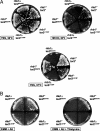Point mutations in TOR confer Rheb-independent growth in fission yeast and nutrient-independent mammalian TOR signaling in mammalian cells
- PMID: 17360675
- PMCID: PMC1805553
- DOI: 10.1073/pnas.0608510104
Point mutations in TOR confer Rheb-independent growth in fission yeast and nutrient-independent mammalian TOR signaling in mammalian cells
Abstract
Rheb is a unique member of the Ras superfamily GTP-binding proteins. We as well as others previously have shown that Rheb is a critical component of the TSC/TOR signaling pathway. In fission yeast, Rheb is encoded by the rhb1 gene. Rhb1p is essential for growth and directly interacts with Tor2p. In this article, we report identification of 22 single amino acid changes in the Tor2 protein that enable growth in the absence of Rhb1p. These mutants also exhibit decreased mating efficiency. Interestingly, the mutations are located in the C-terminal half of the Tor2 protein, clustering mainly within the FAT and kinase domains. We noted some differences in the effect of a mutation in the FAT domain (L1310P) and in the kinase domain (E2221K) on growth and mating. Although the Tor2p mutations bypass Rhb1p's requirement for growth, they are incapable of suppressing Rhb1p's requirement for resistance to stress and toxic amino acids, pointing to multiple functions of Rhb1p. In mammalian systems, we find that mammalian target of rapamycin (mTOR) carrying analogous mutations (L1460P or E2419K), although sensitive to rapamycin, exhibits constitutive activation even when the cells are starved for nutrients. These mutations do not show significant difference in their ability to form complexes with Raptor, Rictor, or mLST8. Furthermore, we present evidence that mutant mTOR can complex with wild-type mTOR and that this heterodimer is active in nutrient-starved cells.
Conflict of interest statement
The authors declare no conflict of interest.
Figures





References
-
- Aspuria PJ, Tamanoi F. Cell Signal. 2004;16:1105–1112. - PubMed
-
- Avruch J, Lin Y, Long X, Murthy S, Ortiz-Vega S. Curr Opin Clin Nutr Metab Care. 2005;8:67–72. - PubMed
-
- Dann SG, Thomas G. FEBS Lett. 2006;580:2821–2829. - PubMed
-
- Inoki K, Guan KL. Trends Cell Biol. 2006;16:206–212. - PubMed
-
- Wullschleger S, Loewith R, Hall MN. Cell. 2006;124:471–484. - PubMed
Publication types
MeSH terms
Substances
Grants and funding
LinkOut - more resources
Full Text Sources
Other Literature Sources
Molecular Biology Databases
Research Materials
Miscellaneous

